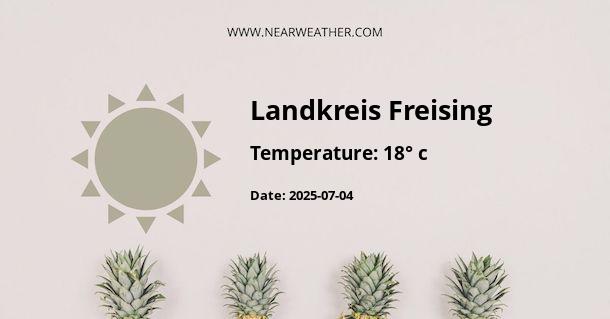Understanding the Climate and Weather Patterns in Landkreis Freising, DE
Landkreis Freising, located in the heart of Bavaria, Germany, near Munich, is characterized by a temperate oceanic climate with continental influence. This region experiences four distinct seasons, each with its variability and weather patterns. To gain a thorough understanding of what this climate entails for residents and visitors alike, we will dive deep into the climatic intricacies and nuances of Freising's weather year-round.
Overview of Landkreis Freising's Climate
The climate in Landkreis Freising is largely shaped by its geographical position and topography. With the Bavarian Alps to the south and the Danube River basin to the north, the region typically sees a mix of weather conditions.
According to the Köppen climate classification, Freising falls under the Cfb category, which corresponds to a temperate oceanic climate with no dry season and a warm summer.
Seasonal Weather Breakdown
Spring (March to May)
-
Temperature: Spring sees a gradual increase in temperature, with average highs ranging from 8°C to 18°C and average lows from 0°C to 7°C.
-
Precipitation: Average monthly rainfall ranges from 40 to 60 mm, with April typically being the wettest spring month.
-
Sunlight: Daylight hours increase, with an average of 4 to 7 hours of sunshine per day by the end of May.
Summer (June to August)
-
Temperature: Summers are pleasantly warm with occasional hot spells. Average high temperatures range from 20°C to 24°C, and lows from 10°C to 13°C.
-
Precipitation: Summer is the wettest season with average monthly rainfall between 80 and 120 mm, influenced by thunderstorms and convectional rains.
-
Sunlight: The region enjoys the longest daylight hours of the year, averaging 7 to 8 hours of sunshine per day.
Autumn (September to November)
-
Temperature: Temperatures decrease steadily, with average highs ranging from 19°C to 6°C and lows from 9°C to 1°C. Late autumn can witness the onset of frost.
-
Precipitation: Rainfall decreases, with an average monthly precipitation of 50 to 70 mm, but the region can experience increased cloud cover and foggy conditions.
-
Sunlight: Daylight diminishes to 3 to 5 hours of sunshine per day by the end of November.
Winter (December to February)
-
Temperature: Winters are cold with average high temperatures ranging from 1°C to 4°C and lows between -3°C and 0°C. Sub-zero temperatures are common, bringing frost and occasional snow.
-
Precipitation: Snowfall can occur, contributing to an average monthly precipitation of 40 to 60 mm in the form of snow and rain.
-
Sunlight: The region experiences the least sunlight of the year, averaging 2 to 3 hours of sunshine per day.
Monthly Average Temperatures and Precipitation
| Month | Average High (°C) | Average Low (°C) | Average Precipitation (mm) | Average Sunshine (Hours) |
|---|---|---|---|---|
| January | 3 | -3 | 50 | 2 |
| February | 4 | -2 | 45 | 3 |
| March | 9 | 0 | 50 | 4 |
| April | 14 | 3 | 60 | 5 |
| May | 18 | 7 | 90 | 7 |
| June | 21 | 11 | 110 | 7 |
| July | 24 | 12 | 120 | 8 |
| August | 23 | 12 | 110 | 8 |
| September | 19 | 9 | 80 | 5 |
| October | 14 | 5 | 60 | 4 |
| November | 7 | 1 | 60 | 3 |
| December | 4 | -2 | 50 | 2 |
Distinct Weather Phenomena
The region experiences a few unique weather phenomena due to its proximity to the Alps and the varied topography
- Föhn Winds
- - These warm, dry winds coming off the Alps can cause rapid temperature increases, even during the cooler months, potentially impacting local ecosystems and human well-being.
- Alpine Influence
- - Weather systems are often modulated by the mountainous terrain, leading to localized weather patterns that differ from the surrounding lowland areas.
- Fog and Inversions
- - During autumn and winter, cold air can become trapped in the lower valleys causing foggy conditions that may persist for days.
Weather Impacts on Agriculture and Tourism
Landkreis Freising's climate has a significant impact on its agricultural practices and tourism industry. The region is renowned for its rich agricultural land, and the climate supports a range of crops, including wheat, barley, hops, and various fruits and vegetables. The changing seasons assure the growth of seasonal produce and influence the patterns of crop rotation and harvest timings.
In the realm of tourism, Freising benefits from its mild summers and picturesque winters, which attract visitors year-round. The region's many festivals, such as the famous Frühlingsfest (spring festival) and Christkindlmarkt (Christmas market), are scheduled around the local weather patterns to maximize visitor comfort and participation.
Climate Change Considerations
The effects of climate change have not spared Landkreis Freising, with observations indicating alterations in long-term weather patterns. The frequency of extreme weather events, such as heatwaves and severe storms, has increased. These changes have implications for local infrastructure, agriculture, and natural ecosystems. The community, along with the broader global village, is now facing the challenge of adapting to these changes and mitigating their impacts on everyday life.
In conclusion, the climate and weather in Landkreis Freising, DE, present a complex but fascinating interplay of natural forces that shape the life in this region. Understanding these patterns is essential for tapping into the opportunities and addressing the challenges presented by this unique environment.
A - Landkreis Freising's Latitude is 48.440830 & Longitude is 11.735000.
A - Weather in Landkreis Freising is -3° today.
A - Climate Conditions in Landkreis Freising shows clear sky today.
A - Humidity in Landkreis Freising is 100% today.
A - Wind speed in Landkreis Freising is 3.71 km/h, flowing at 20° wind direction. today.
